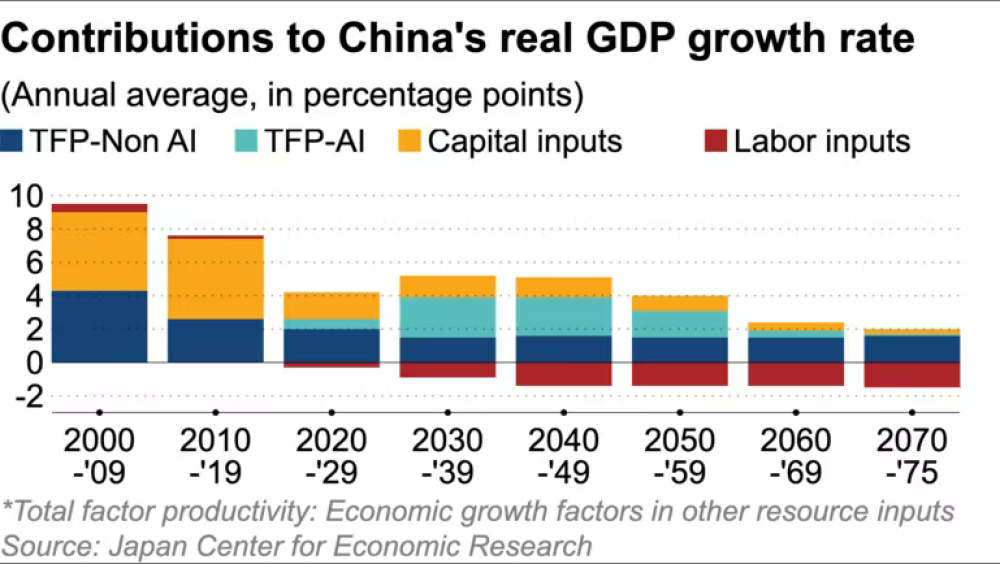TOKYO -- China will be the biggest economic beneficiary of robots equipped with artificial intelligence, narrowing the gap in real gross domestic product with the U.S. over the next three decades. But China may never grow larger than the U.S., economically, as it is likely to be bogged down by future population declines, according to a forecast by a Japanese think tank.
In a long-term economic forecast released on Thursday, the Japan Center for Economic Research predicts that by the end of the 2050s, China's real GDP will be 3.5 times the size it was in 2024. The gap between the world's largest and the second-largest economy is forecast to be the smallest in 2057, with China's economy size reaching 89% of the size of the U.S.
JCER expects the introduction of manufacturing robots equipped with advanced AI -- "artificial general intelligence (AGI)" -- to be the main driver of China's future economic growth. AGI refers to the still-unrealized concept of AI that achieves human-level cognitive abilities.
Discussions about AGI, as well as generative AI, primarily focus on the digital world, or "software" AGI. But the introduction of "physical" AGI in the form of robots, which is expected to reduce demand for human workers and spur greater factory automation, will ultimately benefit China more than other economies, given its manufacturing-focused economy.
The think tank predicts private companies' integration of AGI will be evident in software by 2030, and in the robotics industry by 2035, a forecast it described as "conservative."
JCER updated
the March version of its projection, detailing AI's contribution to total factor productivity. Total factor productivity takes into account all factors contributing to economic growth other than changes in labor and capital inputs, thereby capturing the effect of technological innovation and efficiency gains on GDP.
The Tokyo-based think tank forecasts China's real GDP will grow at an average of 4.3% annually in the 2030s. This growth will be bolstered by the adoption of AGI in the software industry, raising the productivity of the workforce in programming, education and corporate planning, among other applications.
In the 2040s, it predicts China's growth will be around 3.7% per year, slowing as the workforce shrinks, but it expects the country to maintain relatively high growth through the introduction of AGI-controlled robots.
However, from the 2050s onward, economic growth is expected to fall sharply, according to JCER's forecast, as the country's population declines rapidly. The population is estimated to fall 40% from the 2024 level, to 854 million, in 2075. As a result, the report said China's growth rate will be close to zero by 2075.
The U.S., on the other hand, will gain significantly from the AI technology, but not by as much as China does, narrowing the gap.
Even so, the U.S. will continue to experience steady growth over the long term, as it will experience less downward pressure on economic growth due to population declines. The report forecasts real GDP growth of 3.3% per year in the U.S. in the 2030s. The rate is expected to fall steadily to 1.4% by 2075, but it will be higher than China's.
This trend, according to JCER's report, means that China's economy is unlikely to grow larger than that of the U.S. The gap will be closest in 2057 but will widen again thereafter. The forecast does not consider the effects of the recent trade war between the two largest economies.
Many economists predict China's economy will overtake the U.S., although estimates vary on when this is likely to happen.
Hidenobu Ishibashi, principal economist at JCER, highlighted the significance of AI technology on the real economy. Taking the U.S. as an example, his team estimates the annual growth of total factor productivity, an indicator of productivity increases from technological innovation, at 1.7% from 2024 to 2075.
Ishibashi said this is "on par" with the period characterized by the emergence of electricity and automobiles. The indicator grew at the rate of 1.9% between 1919 and 1970, excluding the period from 1942 to 1947 when the economy was in turmoil due to World War II. This was twice the pace recorded between 1970 and 2024.
While some experts raise concerns that the economic gains of AGI may be concentrated in a handful of tech companies, the JCER report is based on a scenario where the economic benefits are redistributed to workers and broader society, according to Ishibashi.
JCER forecast in March that Japan will fall from fourth place in the global GDP ranking to 11th by 2075. The latest report -- based on a scenario of Japan undergoing a series of structural reforms -- suggested a more positive outlook, predicting the island nation will remain in fourth place.
But the report warned that a comprehensive restructuring is required for Japan to maintain its position, including better workforce mobility and tax reforms, as well as increased investment in startups to foster AI and digital technology adoption.





